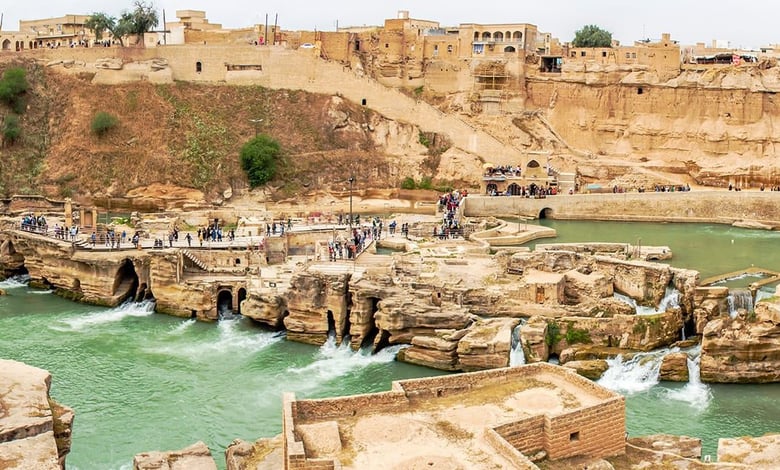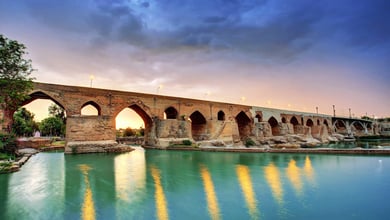Shushtar Historical Hydraulic System: A Masterpiece of Engineering
An Engineering Marvel

Shushtar Historical Hydraulic System is one of Iran’s most amazing UNESCO World Heritage Sites. Located in the southwest of Iran, near the city of Ahwaz, it’s an ensemble of dams, manmade rivers, bridges, mills, and even a castle, built 2500 years ago on the Karun River, Iran’s largest river.
Not only it’s a masterpiece of engineering, but it also creates stunning scenery. So if you’re planning your next trip to Iran, make sure to make some room to visit Shushtar Historical Hydraulic System.
Contents
What is Shushtar Historical Hydraulic System?

Shushtar Historical Hydraulic System is an incredible complex built around the Karun River, which origins can be traced back to Darius the Great’s era, in the 5th Century BC. The Achaemenids had found a way to control the water flow to irrigate the semi-arid lands of the region and provide water to the population.
Shushtar Historical Hydraulic System is not just a dam, but it’s a vast network of bridges, canals, dams, basins, cascades, watermills, natural and manmade rivers, diversion and irrigation systems. It also has defensive structures and a place called “Sika”, dedicated to rest and recreation. At the center of the whole system was the Salasel Castel, functioning as an operation center of the hydraulic system.

To picture the Shushtar Historical Hydraulic System in a simple way, we have to start with the Karun River, Iran’s largest river, located in the Khuzestan province. Two canals derive from the river, among which the Gargar canal, still in use nowadays. The Achaemenids first built the Gargar Dam to contain the water flow. From this dam, three tunnels lead the water into the complex, which is then dispatched among the various canals to serve different purposes. The water then pours out like a waterfall into basins and continues its way to irrigate other areas.
What was the Complex Made for?
Evidently, the Shushtar Historical Hydraulic System was built with a precise goal and was not a simple display of know-how or power. Every single structure of the complex has a specific function and application, all being interconnected.
The main function of the Shushtar Historical Hydraulic System is to provide water equally to the city and to protect it, by preventing the Karun River from overflowing. It allowed the irrigation of semi-arid lands and mills used to produce floor, playing a crucial role in the development of agriculture and industry. The complex made possible the construction of a new town, as well as planting of orchards and farming over an area of 40.000 hectares.
Eventually, Shushtar Historical Hydraulic System was also a means of transportation, communication and trade.

A UNESCO’s Masterpiece of Creative Genius
This interconnected ensemble is recognized by UNESCO as an amazing example of human interaction with the environment. It was registered as a World Heritage Site in 2009 and is inscribed as a “masterpiece of creative genius”. The site indeed reflects the knowledge of the Elamites and Mesopotamians, among the world’s oldest civilizations.
The site is exceptional both because of the diversity of its civil engineering structures and because of the diversity of their use. The Shushtar Historical Hydraulic System would indeed provide urban water supply, irrigate lands, power mills, among other functions.

Most of the complex is built in stone, brick and mortar. Part of the structures have been damaged and disappeared over time, but many ancient structures have remained, a few still functioning. Among the oldest parts dating back from the Achaemenid era (550 – 330 BC) is the dam “Band Mizan”, a true masterpiece of ancient engineering. This dam divides the Karun River into two branches to regulate its flow. The Salasel also dates back to the Achaemenid.
From the Achaemenids to the Sassanids
Later, under the Sassanid era (224 – 651 CE) many constructions were added. Several important bridges were built over a manmade river, the Gargar Channel, whose bed is entirely paved. The Shahdorvan Weir Bridge was one of them: it was built by Roman soldiers and engineers made captive by King Shapur I, along with the Roman Emperor Valerian. The Lashkar Weir Bridge is another important bridge built by the Sassanid, as it played a critical role in connecting the city of Shushtar to other villages and channeling the water to increase floor cultivation.
With the expansion of the city, many other kinds of structures were added, such as stables, barracks, baths, a bakery, a kitchen, and courtyards, to become, at some point, the residence of the Governor of Khuzestan Province.
Another amazing feature is the Pergola Tower. This octagonal tower is located on a pedestal four meters above the ground, overlooking the Mirzan Dam. Its function is still unclear. It could have been a watchtower or a tower used to monitor the water’s volume and intensity of the river flow.

When and How to Visit Shushtar Historical Hydraulic System?
Because of its location, most travellers miss their chance to visit Shushtar Historical Hydraulic System during their trip to Iran. While it’s one of the most beautiful and interesting UNESCO sites Iran has, it is indeed situated outside the “classic route” that focuses mainly on Central Iran. Yet, it’s worth making a small detour.
Shushtar Historical Hydraulic System is located in Khuzestan Province, in the southwest of Iran. You can visit this UNESCO site on a day tour from Ahwaz, the province’s capital, located less than two hours south of Shushtar. The best way to reach Ahwaz is by flight from Tehran or Shiraz (there are flights between these cities 5 days per week) and you’ll find several accommodation options in the city.

Keep in mind that Khuzestan is Iran’s warmest province: In summer, the temperatures can exceed 50 degrees! It’s thus recommended to visit Shushtar between October and May, preferably during winter, to have the most suitable temperatures.
You can also combine your visit with two other interesting historical sites nearby. One is Choqa Zanbil, an ancient pyramidal structure built by the Elamite in 1250 BC. And the other one is the historical city of Susa, once one of the most important in the region, which holds the Tomb of Daniel.
Read More






